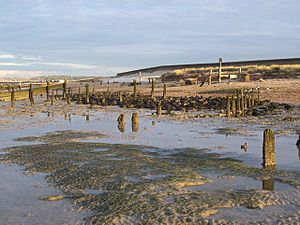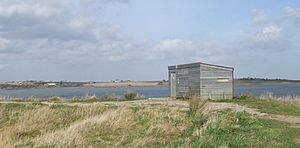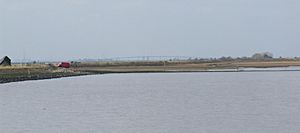The Swale facts for kids
| Site of Special Scientific Interest | |
 |
|
| Area of Search | Kent |
|---|---|
| Interest | Biological |
| Area | 6,509.4 hectares (16,085 acres) |
| Notification | 1990 |
| Location map | Magic Map |
|
Designations
|
|
| Official name: The Swale | |
| Designated: | 17 July 1985 |
|---|---|
| Reference #: | 299 |
The Swale is a special water channel in Kent, England. It's like a natural river that separates the Isle of Sheppey from the rest of Kent. This area is very important for nature. It's a huge Site of Special Scientific Interest (SSSI), which means it's protected because of its amazing wildlife.
The Swale is also a Ramsar site, which is an international award for important wetlands. Plus, it's a Special Protection Area for birds. Many parts of The Swale are also nature reserves, looked after by different groups like the Kent Wildlife Trust.
History of The Swale
The name "Swale" comes from an old English word. It means "swirling, rushing river" or "rushing water." This name fits well because the water here moves with the tides.
Long, long ago, around 6500 BC, the eastern coast of Great Britain was much bigger. The Isle of Sheppey was actually connected to the mainland. The area where The Swale is now was a river valley. As the sea levels slowly rose, water filled this valley. This created the channel we see today, separating the Isle of Sheppey from the rest of Kent.
When the Romans came to Britain, The Swale was much wider. One part of the Isle of Sheppey, called the Isle of Harty, was even a separate island back then. People used ferry boats to cross The Swale in two places. One ferry went between Oare and Harty. Another went between Murston (near Sittingbourne) and Elmley on the Isle of Sheppey.
Today, the Isle of Harty is no longer a separate island. Marshlands have slowly filled in parts of the channel. However, The Swale is still a busy waterway. It needs to be regularly cleared to keep it open for boats.
Two bridges now cross The Swale at its western end. These are the Kingsferry Bridge and the newer Sheppey Crossing.
Nature and Wildlife

The Swale is a very important place for nature. It is a National Nature Reserve and a Special Protection Area. This means it's protected because of the special plants and animals that live here.
You can find unique plants like eel grass, Ray's knotgrass, white seakale, glassworts, and golden samphire. These plants help support rare and uncommon insects. You might see migrant butterflies and moths, including the Essex emerald and the clouded yellow butterfly. Rare hawk-moths also live here.
Since 1968, The Swale has been a Site of Special Scientific Interest (SSSI). This protection helps keep its natural beauty and wildlife safe for the future.
Birds of The Swale
The Swale is a fantastic place for birds. Many different kinds of birds live here or visit during their migrations. It provides important homes for them.
Some of the birds you might see include:
- Avocet (Recurvirostra avosetta) - A large number of Britain's breeding avocets live here.
- Marsh harrier (Circus aeruginosus) - Many of Britain's breeding marsh harriers also live here.
- Mediterranean gull (Larus melanocephalus)
- Bar-tailed godwit (Limosa lapponica)
- Eurasian golden plover (Pluvialis apricaria)
- Hen harrier (Circus cyaneus)
- Ringed plover (Charadrius hiaticula)
- Black-tailed godwit (Limosa limosa islandica)
- Grey plover (Pluvialis squatarola)
- Knot (Calidris canutus)
- Pintail (Anas acuta)
- Common redshank (Tringa totanus)
- Shoveller (Anas clypeata)



